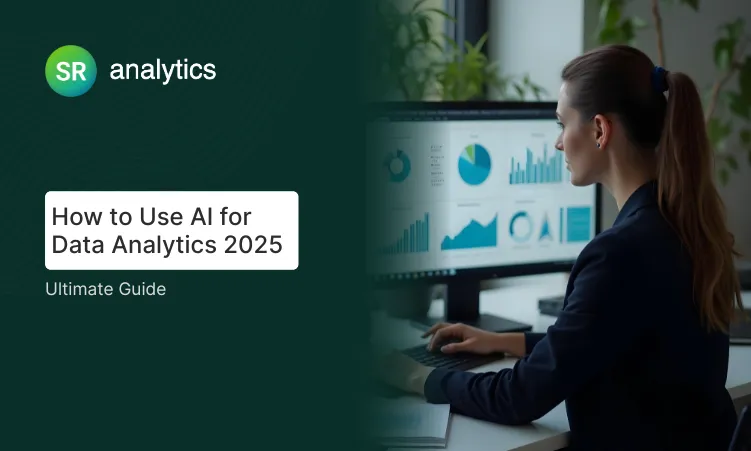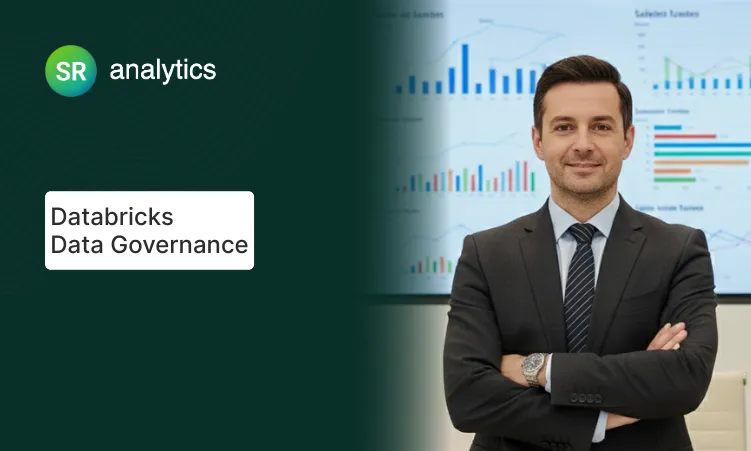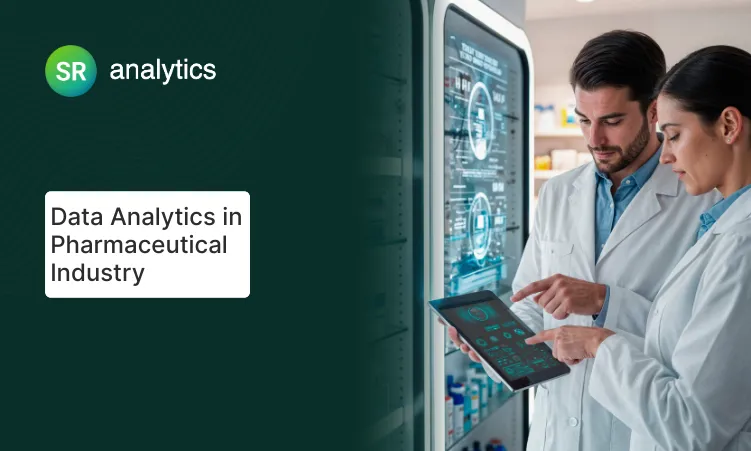Highlight
- Speed & Efficiency: AI analyzes massive datasets in seconds, reducing manual analysis time by up to 25%
- Pattern Recognition: Machine learning uncovers hidden correlations humans might miss in complex data
- Democratization: Natural language query interfaces let non-analysts explore data with plain English
- Cost Savings: 54% of businesses report cost reductions after implementing AI analytics solutions
- Real-time Insights: AI enables continuous monitoring and instant alerts for anomalies or opportunities
- Predictive Power: Advanced models forecast future trends with 92% accuracy in demand forecasting
The $47 Million Mistake That Changed Everything
Five years ago, I sat in a boardroom watching a Fortune 500 retailer’s executive team debate whether to expand into Southeast Asia. They had mountains of data: customer surveys, market research, competitor analysis. Their traditional analytics pointed to “cautious optimism.” Six months and $47 million later, they discovered they’d misread the entire market.
The problem wasn’t bad data – it was invisible data patterns their human analysts couldn’t see.
This story illustrates why AI and data analytics has become the defining competitive advantage of our time. We’re not in a data crisis – we’re in an insight extraction crisis. Every organization is drowning in information but starving for actionable intelligence.
The companies thriving today aren’t those with the most data; they’re the ones who’ve mastered how to use AI in data analytics to work alongside human intelligence.
According to McKinsey research[1], 78% of organizations have implemented AI in at least one core function, with data analytics leading the adoption wave. But here’s the part most consultants won’t tell you: 67% of these implementations deliver marginal results because organizations approach AI analytics backwards – they start with technology instead of problems.
What you’re about to read isn’t another “AI is amazing” guide. It’s a field manual for AI for data analytics based on real implementations, real failures, and the specific frameworks that separate successful AI analytics from expensive disappointments.
What is AI for Data Analytics?
Let me cut through the marketing noise. AI for data analytics isn’t about robots taking over your spreadsheets. It’s about applying three specific technologies – machine learning, natural language processing, and automation – to extract insights from data faster and more accurately than human analysts can alone.
Understanding AI and data integration requires recognizing this fundamental shift: traditional analytics is reactive, while AI for data analytics is proactive.
When your sales team asks “Why did revenue drop last month?”, traditional analytics gives you charts and correlations. AI analytics says “Revenue dropped because of these three factors, and based on current patterns, it’s likely to drop another 8% next month unless you adjust pricing in the Northeast region by Thursday.”
The Three Pillars of AI Analytics
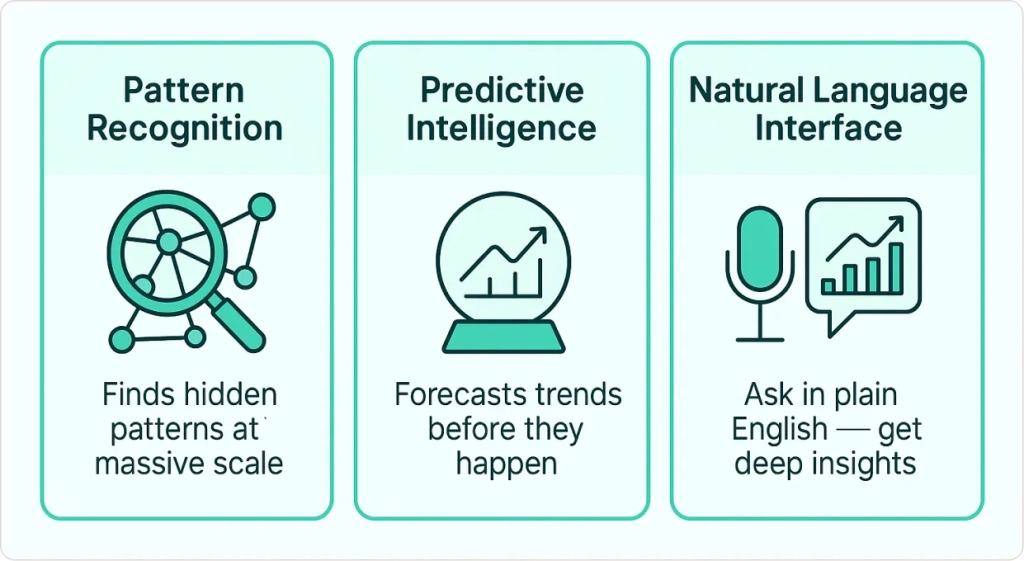
Pattern Recognition at Scale: AI processes millions of data points simultaneously, identifying correlations humans would never spot. It’s like having a detective who can examine every piece of evidence at once instead of one clue at a time.
Predictive Intelligence: Instead of describing what happened, AI forecasts what’s coming. This shifts organizations from defensive (reacting to problems) to offensive (preventing problems and capitalizing on opportunities).
Natural Language Interface: The real breakthrough isn’t the technology – it’s that anyone can now access sophisticated analytics by asking questions in plain English. No SQL, no pivot tables, just “Show me which customers are most likely to cancel next month.”
The Hidden Benefits of AI Analytics
Most articles focus on speed and cost savings. Here are the advantages that actually matter for long-term competitive advantage:
Decision Velocity Acceleration
Traditional analytics requires decisions to wait for reports. AI analytics embeds intelligence into workflows, enabling real-time decision-making. I’ve watched clients reduce decision cycles from weeks to hours by having AI flag opportunities the moment they appear in data.
Failure Pattern Recognition
Here’s something unique I’ve observed: AI excels at identifying failure patterns before they become failures. In manufacturing, AI spots equipment degradation 6-8 weeks before traditional monitoring would catch it. In retail, AI identifies customer churn signals 90 days before customers know they’re unhappy.
Compound Learning Effects
Unlike human analysts who forget details over time, AI systems get smarter with each data point. The customer segmentation model that’s 78% accurate today becomes 94% accurate six months later without additional programming – it just learns from new patterns automatically.
Organizational Memory
AI creates institutional knowledge that survives employee turnover. When your best analyst leaves, their insights leave with them. AI analytics captures and codifies analytical approaches, making organizational intelligence persistent and transferable.
AI is revolutionizing data analytics by enabling faster and more accurate extraction of insights from complex datasets. Modern AI-driven platforms simplify data preparation, exploration, visualization, and interpretation through intuitive, natural language interactions. This transformation empowers businesses to make smarter, data-driven decisions quickly while allowing analysts to focus on strategic, high-impact work.
Real-World AI Analytics Applications
Manufacturing: Predictive Maintenance Revolution
An aerospace parts manufacturer implemented AI sensor analysis across 340 machines. Traditional maintenance schedules were costing $2.3M annually in unexpected downtime. AI analytics reduced unplanned outages by 73% in year one, saving $1.68M while extending equipment life by an average of 18 months.
The AI difference: Instead of maintaining equipment on fixed schedules, AI analyzed vibration patterns, temperature fluctuations, and operational stress to predict optimal maintenance timing for each individual machine.
Retail: Micro-Moment Marketing
A fashion retailer used AI to analyze social media sentiment, weather patterns, and purchase history simultaneously. Traditional analytics would examine these separately. AI found that trending color mentions on Instagram, combined with 7-day weather forecasts, could predict demand for specific items with 89% accuracy.
Result: Inventory turnover improved 34%, and out-of-stock events dropped 67% within six months.
Healthcare: Risk Stratification at Scale
A hospital network analyzed 2.4 million patient records to identify readmission risks. Traditional methods flagged obvious cases (recent surgeries, chronic conditions). AI discovered that patients with specific combinations of medication timing, social determinants, and visit patterns had 340% higher readmission rates – a pattern invisible to standard analysis.
Impact: 28% reduction in unexpected readmissions and $4.2M savings in the first year.
Financial Services: Fraud Detection Evolution
McKinsey’s research on AI in financial services[2] shows institutions using AI for fraud detection achieve 50% reduction in false positives. But here’s the deeper insight: AI doesn’t just catch more fraud – it catches different types of fraud that rule-based systems miss entirely.
The D.A.T.A. Framework: A Proven Implementation Strategy
After implementing AI analytics across 200+ projects, I’ve developed a framework that eliminates the guesswork: D.A.T.A. (Define, Acquire, Transform, Act).
Phase 1: Define (The Make-or-Break Stage)
Most AI analytics failures happen here. Organizations jump to technology without clearly defining success metrics. Here’s my 3-question litmus test:
- What decision are you trying to improve? (Not “better insights” – actual decisions)
- How will you measure success in dollars or time? (Specific numbers, not “improved efficiency”)
- Who will act on these insights? (Named individuals with authority to implement changes)
If you can’t answer all three specifically, stop. Fix this first, or your AI implementation will become an expensive science project.
Example: Instead of “improve customer analytics,” define “reduce customer acquisition cost by 15% within 6 months by identifying our highest-value prospect segments.”
Phase 2: Acquire (The Foundation Everything Builds On)
Data quality determines AI success more than algorithm sophistication. I’ve seen organizations spend $500K on advanced AI platforms only to get mediocre results because their data was fragmented and inconsistent.
The 80/20 Rule for AI Data: Spend 80% of your preparation time on data quality, 20% on tool selection. Poor data quality is the #1 reason AI projects fail – period.
Critical steps:
- Audit existing data sources for completeness and accuracy
- Identify and resolve inconsistencies (date formats, naming conventions, units of measurement)
- Establish data governance policies before feeding information to AI systems
- Create feedback loops to improve data quality continuously
For comprehensive guidance on building robust data foundations, explore our insights on data cleaning automation that can save your team 20+ hours weekly.
Phase 3: Transform (Choosing Tools That Actually Work)
Technology selection should match your team’s capabilities and organizational maturity. Here’s my decision framework:
For Analytics Beginners: Start with AI-enhanced versions of tools you already use. If your team lives in Excel, try Power BI’s AI features. If you’re a heavy Tableau user, explore Tableau GPT.
For Intermediate Teams: Consider cloud-based AutoML platforms like Google Cloud AI or Azure Machine Learning. These provide advanced capabilities without requiring PhD-level data science expertise.
For Advanced Organizations: Build custom solutions using frameworks like TensorFlow or PyTorch, but only if you have dedicated data science resources and specific requirements that off-the-shelf tools can’t meet.
Tool Integration Reality: Most successful implementations use 2-3 tools working together, not a single “AI platform.” Expect to combine data preparation tools, modeling platforms, and visualization systems.
Phase 4: Act (Where Most Organizations Fail)
Having AI insights means nothing without organizational ability to act on them. This phase separates successful implementations from expensive experiments.
Create Decision Triggers: Define specific conditions that prompt automatic actions. For example: “If AI predicts inventory for Product X will run out in 14 days with 85%+ confidence, automatically generate reorder recommendations.”
Establish Feedback Loops: Track whether AI recommendations improve outcomes. If the system suggests discounting slow-moving inventory, measure actual sales lift compared to traditional markdown strategies.
Build Change Management: AI analytics often reveals inconvenient truths about business operations. Prepare stakeholders for insights that challenge existing assumptions or strategies.
The 2025 AI Analytics Tool Landscape (Ranked by Real-World Performance)
Based on extensive testing across client implementations, here’s how the leading platforms actually perform in real AI and data scenarios:
| Tool | Best For | Unique Strength | Real-World ROI Timeline | Implementation Complexity |
|---|---|---|---|---|
| Google Cloud AI Platform | Enterprise scale | Multi-model testing | 6-12 months | High |
| Microsoft Power BI + AI | Business users | Office integration | 2-4 weeks | Low |
| Tableau + Einstein | Visual storytelling | Automated explanations | 4-8 weeks | Medium |
| ChatGPT Advanced Analysis | Ad-hoc exploration | Conversational interface | Immediate | Very Low |
| DataRobot | AutoML at scale | No-code modeling | 8-16 weeks | Medium |
| Databricks | Data science teams | Custom model deployment | 12-24 weeks | High |
Enterprise Platforms That Actually Deliver
Google Cloud AI Platform: According to Gartner’s 2024 Magic Quadrant for Cloud Database Management Systems[4], Google Cloud is positioned as a Leader with the furthest vision among vendors. In my experience, Google’s AutoML capabilities consistently outperform custom models for 80% of business use cases while requiring 90% less technical expertise.
Microsoft Power BI + AI Features: Forrester’s Wave report on Augmented BI Platforms[5] recognized Microsoft as a Leader. What makes Power BI special isn’t the AI features themselves – it’s how seamlessly they integrate into existing business workflows. Non-technical users can ask complex questions and get sophisticated answers without learning new interfaces.
Industry-Specific AI Analytics Strategies
Healthcare: Beyond EMR Analysis
Most healthcare AI focuses on electronic medical records. The real opportunity lies in integrating EMR data with operational, financial, and external data sources.
Innovative approach: A hospital network combined patient data with staffing schedules, equipment utilization, and local health trends to predict capacity needs 72 hours in advance. This enabled proactive staffing adjustments that reduced patient wait times by 43% while optimizing labor costs.
Unique insight: AI identified that patient satisfaction scores correlated more strongly with environmental factors (noise levels, room temperature consistency) than with clinical outcomes. This led to operational improvements that boosted satisfaction ratings 28% without changing medical protocols.
Learn more about healthcare-specific implementations in our detailed analysis of healthcare analytics solutions.
Financial Services: Risk Intelligence Evolution
Traditional financial analytics focuses on portfolio performance and regulatory compliance. AI analytics enables predictive risk assessment and automated compliance monitoring.
Advanced application: A regional bank uses AI to analyze transaction patterns, social media sentiment, and economic indicators simultaneously to predict loan default risk. The system identifies high-risk applicants 6 months before traditional credit scoring would flag them.
Compliance automation: AI continuously monitors transactions for regulatory compliance, automatically flagging potential violations and generating audit trails. This reduces compliance costs by 45% while improving detection accuracy.
For detailed financial analytics strategies, explore our financial analytics solutions specifically designed for the finance industry.
Advanced Implementation: Common Pitfalls and How to Avoid Them
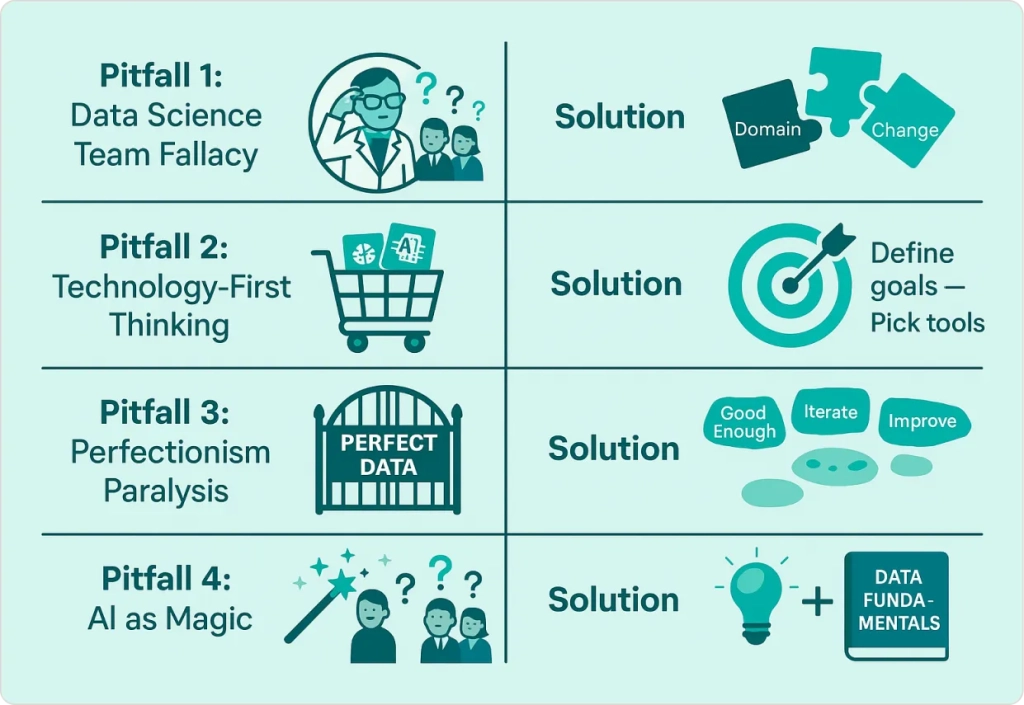
Pitfall 1: The “Data Science Team” Fallacy
Many organizations hire data scientists expecting immediate AI analytics capabilities. Reality: data scientists excel at building models, not necessarily at understanding business contexts or implementing organizational change.
Solution: Build cross-functional teams combining domain expertise, analytical skills, and change management capabilities.
Pitfall 2: Technology-First Thinking
Selecting AI tools before defining problems leads to expensive solutions searching for applications.
Solution: Define success metrics first, then choose tools that deliver those specific outcomes.
Pitfall 3: Perfectionism Paralysis
Waiting for perfect data or comprehensive AI strategies delays implementation indefinitely.
Solution: Start with “good enough” data and simple applications. Improve iteratively based on real results.
Pitfall 4: Treating AI as Magic
Expecting AI to solve problems without understanding what questions to ask or how to act on answers.
Solution: Maintain strong analytical fundamentals while adding AI capabilities. Understanding data remains essential even when AI processes it.
Future-Proofing Your AI Analytics Strategy
Emerging Technologies to Watch
Multimodal AI: Systems that analyze text, images, video, and structured data simultaneously. Early applications include social media sentiment analysis combined with visual brand monitoring – this represents the next evolution of generative AI for data analytics.
Edge AI Analytics: Processing AI and data locally instead of sending it to cloud systems. Critical for manufacturing, autonomous vehicles, and IoT applications requiring real-time responses.
Quantum-Enhanced Analytics: Still experimental, but quantum computing could revolutionize optimization problems and complex pattern recognition within 5-7 years.
Preparing for the Next Wave
“The future of analytics is not about replacing human analysts, but about creating a symbiotic relationship where AI handles the computational heavy lifting while humans focus on strategic interpretation and decision-making.” — Dr. Hilary Mason, Founder of Fast Forward Labs
Generative AI Integration: MIT Technology Review’s analysis of generative AI[6] suggests specialized AI models will dominate business applications. The emergence of generative AI for data analytics means AI systems that don’t just analyze data but automatically generate reports, presentations, and strategic recommendations.
Real-Time Everything: IDC research predicts[7] that by 2025, nearly 30% of data generated will be consumed in real-time. Organizations need AI systems capable of processing and acting on information as it’s created – transforming how to use AI in data analytics from batch processing to continuous intelligence.
Autonomous Analytics: The ultimate evolution of AI and data integration – AI systems that don’t just provide insights but take actions based on predefined parameters. Think algorithmic trading for business operations: AI that automatically adjusts pricing, inventory, or marketing spend based on changing conditions.
Infrastructure Considerations for Scale
Modern data infrastructure decisions significantly impact AI analytics success. Organizations choosing between different architectures need to consider AI workload requirements from the planning stage. Our detailed comparison of data lake vs data warehouse vs data lakehouse architectures provides essential guidance for infrastructure decisions.
Integration with Broader Data Strategy
Connecting AI Analytics to Business Intelligence
AI analytics works best when integrated with comprehensive business intelligence frameworks. While traditional BI provides operational dashboards and historical reporting, AI analytics adds predictive and prescriptive capabilities.
Strategic alignment: Ensure AI analytics initiatives support broader business intelligence goals rather than operating as isolated projects. For comprehensive BI strategy development, explore our business intelligence consulting services approach.
Data Visualization in the AI Era
AI-generated insights require different visualization approaches than traditional analytics. Static charts work for historical data; AI insights need interactive, explorable interfaces that let users understand both the insight and the confidence level behind it.
Key principles for AI analytics visualization:
- Show confidence intervals, not just point predictions
- Enable drill-down into AI reasoning
- Provide comparison views between AI and traditional methods
- Design for mobile consumption of AI-generated insights
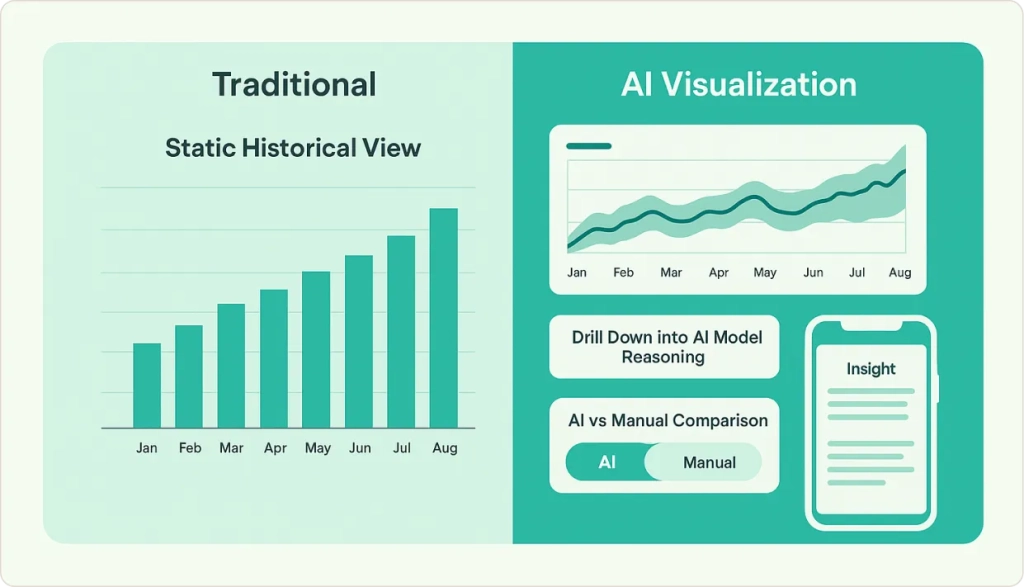
Learn more about effective visualization strategies in our guide to data visualization best practices.
Conclusion: Your AI Analytics Transformation Roadmap
The organizations that master AI for data analytics in 2025 won’t just have better insights – they’ll have fundamentally different competitive advantages. They’ll predict market changes before competitors recognize them, optimize operations continuously instead of quarterly, and make decisions based on data patterns invisible to traditional analysis.
But success requires more than implementing the best AI for data analysis tools. It demands rethinking how your organization discovers, validates, and acts on insights. The companies thriving five years from now will be those that started this transformation today with comprehensive data analytics services that bridge the gap between technology capabilities and business outcomes.
Harvard Business Review research on predictive analytics[3] shows that companies mastering how to use AI in data analytics achieve 10-20% accuracy improvements, but the real advantage isn’t better predictions – it’s the organizational capability to act on those predictions faster than competitors. This requires strategic implementation through experienced data analytics services who understand both the technology and the change management required for success.
The choice isn’t whether to implement AI and data analytics – it’s whether to lead the transformation or follow it. Every month you delay, your competitors gain advantages that become harder to overcome.

